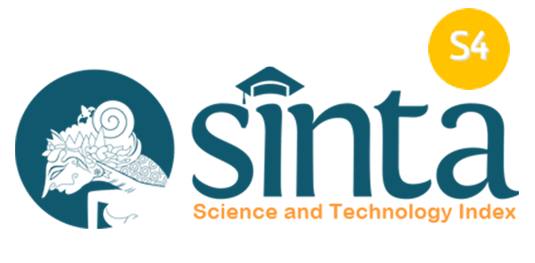The Correlation Between the Students’ Reading Habits and Motivation Toward Their Reading Comprehension at the Eighth Grade of SMPN 13 Mataram
Penulis
Abdullah Jundi , Lalu Thohir , Agus Saputra , Lalu NurtaatDOI:
10.29303/goescienceed.v5i3.422Diterbitkan:
2024-08-28Terbitan:
Vol 5 No 3 (2024): AgustusKata Kunci:
A correlation, reading habits, reading motivation, reading comprehension, eighth-grade studentsAbstrak
The objective of this study was to investigate the correlation between students' reading habits and motivation toward their reading comprehension at SMPN 13 Mataram, specifically among eighth-grade students. The number of samples were 32 participants at the eighth grade SMPN 13 Mataram selected using cluster sampling. This study was conducted using a quantitative method and a correlational research design by using product-moment coefficient correlation analysis. The research employed a correlational method, utilizing questionnaires and tests as data collection tools implemented with IBM SPSS 27. The findings revealed significant correlations between reading habits, reading motivation toward their reading comprehension among eighth-grade students at SMPN 13 Mataram. The statistical analysis shows the following correlation coefficients: Reading habits and reading comprehension: 0.118, with a significance value less than 0.05. Reading motivation and reading comprehension:0.99, with a significance value less than 0.05. Reading habits and reading motivation toward their reading comprehension: 0.037, with a significance value less than 0.05. Since all correlations are statistically significant (p < 0.05), the alternate hypothesis (Ha) is accepted and the null hypothesis (H0) is rejected. This indicates that there are significant correlations between reading habits, reading motivation, and reading comprehension. Keywords: A correlation, reading habits, reading motivation, reading comprehension, eighth-grade students.Referensi
Aaron, R. L., Miller, L., & Smith, E. (1975). Reading habits of behaviorally disordered males: A study. Journal of Reading, 19(1), 28-32.
Afzal, N. (2019). A study on vocabulary-learning problems encountered by BA English majors at the university level of education. Arab World English Journal (AWEJ) Volume, 10.
Arikunto, S. (2006). Prosedur Penelitian Suatu Pendekatan Praktek, Edisi Revisi V. Jakarta: Penerbit Rineka Cipta.
Bishop, D. V., & Adams, C. (1990). A prospective study of the relationship between specific language impairment, phonological disorders and reading retardation. Journal of Child Psychology and Psychiatry, 31(7), 1027-1050.
Cranton, P. (2002). Teaching for Transformation. New Directions for Adult and Continuing Education Journal, (93), 63-72.
Chall, J. S., Jacobs, V. A., & Baldwin, L. E. (1990). The Reading Crisis: Why Poor Children Fall Behind. Harvard University Press.
Fraenkel, J. R., & Wallen, N. E. (2009). How to Design and Evaluate Research in Education. New York: McGraw-Hill Education.
Guthrie, J. T., McRae, A., & Klauda, S. L. (2007). Contributions of concept-oriented reading instruction to knowledge about interventions for motivations in reading. Educational Psychologist, 42(4), 237-250.
Handayani, D., Afiah, N. N., & Yudianto, I. (2020). The influence of internal control system, information technology utilization, and organizational commitment on government accountability performance. Journal of Accounting Auditing and Business-Vol, 3(2).
Ibrahim, A., Alang, A. H., Madi, Baharuddin, Ahmad, M. A., & Darmawati. (2018). Metodologi Penelitian. Makassar: Gunadarma Ilmu.
Knoester, M. (2010). Independent reading and the ‘Social Turn’: How adolescent reading habits and motivation relate to cultivating social relationships. Networks: An Online Journal for Teacher Research, 12(1), 332-332.
Lail, H. (2020). Answering reading texts on English try-out test based on the 12th grade students’ strategies at SMA Negeri 1 Kuripan Lombok Barat. Journal of Languages and Language Teaching, 7(1), 3-5.
Linse, C. T., & Nunan, D. (2005). Practical English Language Teaching for Young Learners. New York: McGraw-Hill ESL/ELT Companies.
Lyon, G. R. (1998). Why reading is not a natural process. Educational Leadership, 55(6), 14-18.
Luna-Reyes, L. F., & Andersen, D. L. (2003). Collecting and analyzing qualitative data for system dynamics: Methods and models. System Dynamics Review: The Journal of the System Dynamics Society, 19(4), 271-296.
Marsela, S. (2017). The correlation between reading motivation and reading comprehension achievement of the eleventh grade students of MAN 2 Palembang (Doctoral dissertation, UIN Raden Fatah Palembang).
McKeown, M. G., Beck, I. L., & Blake, R. G. (2009). Rethinking reading comprehension instruction: A comparison of instruction for strategies and content approaches. Reading Research Quarterly, 44(3), 218-253.
Ogbodo, R. O. (2002). Effective Study Habits and Examination Guide for Students. Abuja: Grace Channel Publishers.
Rahmah, N., Tahir, M., & Talib, A. (2023). The effect of vocabulary mastery on students' reading comprehension. International Journal of Business English and Communication, 1(1), 36-44.
Riadi, S., Sukardi, S., & Hakim, M. (2019). Human resources management in middle school vocational state 4 Mataram. International Journal of Multicultural and Multireligious Understanding, 6(6), 286-292.
Rengur, Z., & Sugirin, S. (2019, July). The effectiveness of using comic strips to increase students’ reading comprehension for the eighth grade students of SMPN 1 Pundong. In 6th International Conference on Educational Research and Innovation (ICERI 2018) (pp. 511-515). Atlantis Press.
Sartika, F. (2020). The correlation between students’ reading habit and their reading comprehension (Unpublished master's thesis). Universitas Pendidikan Indonesia, Bandung.
Sugiyono. (2010). Metode Penelitian Pendidikan Pendekatan Kuantitatif, Kualitatif, dan R&D. Bandung: Alfabeta.
Sugiyono. (2017). Metode Penelitian Kuantitatif, Kualitatif dan R&D. Bandung: Alfabeta.
Thohir, M. (2017). Motivasi Belajar: Teori dan Aplikasinya dalam Pembelajaran. Yogyakarta: Pustaka Pelajar.
Lisensi
Hak Cipta (c) 2024 Jurnal Pendidikan, Sains, Geologi, dan Geofisika (GeoScienceEd Journal)

Artikel ini berlisensiCreative Commons Attribution-ShareAlike 4.0 International License.












